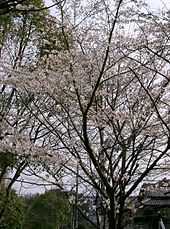Prunus × yedoensis
| Prunus × yedoensis | |
|---|---|
 | |
| Yoshino cherry tree in flower | |
| Scientific classification | |
| Kingdom: | Plantae |
| (unranked): | Angiosperms |
| (unranked): | Eudicots |
| (unranked): | Rosids |
| Order: | Rosales |
| Family: | Rosaceae |
| Genus: | Prunus |
| Subgenus: | Cerasus |
| Species: | P. × yedoensis |
| Binomial name | |
| Prunus × yedoensis Matsum. | |
Prunus × yedoensis (synonym Cerasus x yedoensis, also known as Yoshino cherry; Japanese: 染井吉野 somei-yoshino) is a hybrid cherry of unknown origin, probably between Prunus speciosa as father plant and Prunus pendula f. ascendens as mother.[1] It occurs as a natural hybrid in Japan and is now one of the most popular and widely planted cultivated flowering cherries (sakura) in temperate climates worldwide.[2][3]
Description
Prunus × yedoensis is a small, deciduous tree that at maturity grows to be 5 to 12 metres (16–39 ft) (rarely 15 metres (49 ft) ) tall. It grows well in hardiness zones 5–8 and does well in full sun and moist but well drained soil. The leaves are alternately arranged, 6 to 15 centimetres (2.4–5.9 in) long and 4 to 7 centimetres (1.6–2.8 in) broad, with a serrated margin; they are often bronze-toned when newly emerged, becoming dark green by summer.
The flowers emerge before the leaves in early spring; they are fragrant, 3 to 3.5 centimetres (1.2–1.4 in) in diameter, with five white or pale pink petals. The flowers grow in clusters of five or six together.
The fruit, a small cherry, is a globose drupe 8 to 10 millimetres (0.31–0.39 in) in diameter; they are an important source of food for many small birds and mammals, including robins and thrushes. The fruit contain little flesh and much concentrated red juice, which can stain clothing and brick. The fruit is only marginally sweet to the human palate.[2][3]
Cultivation

Because of its fragrant, light pink flowers, manageable size, and elegant shape, the Yoshino cherry is often used as an ornamental tree. Many cultivars have been selected; notable examples include 'Akebono', 'Ivensii', and 'Shidare Yoshino'.[2]
From the Edo period to the beginning of the Meiji period, gardeners and craftsman who made the village at Somei in Edo (now Komagome, Toshima ward, Tokyo) grew someiyoshino. They first offered them as Yoshinozakura, but in 1900, they were renamed someiyoshino by Dr. Fujino.[4] This is sometimes rendered as 'Somei-Yoshino'.
The Yoshino cherry was introduced to Europe and North America in 1902.[5] This tree, along with the cultivar Kwanzan (derived from the related Prunus serrulata), is responsible for the spectacular pink show each spring in Washington D.C. and other cities. Several of 2000 Japanese cherry trees given to the citizens of Toronto by the citizens of Tokyo in 1959 were planted in High Park.
Origin debates
In 1916, Ernest Henry Wilson had thought that Japanese sakura somei Yoshino was a crossbreed of two wild species of Japanese sakura. In 1933, the Japanese botanist Gen'ichi Koizumi reported that Prunus × yedoensis originated on Jeju island, South Korea.[6] In 1995 DNA fingerprinting technology was used to conclude that the trees grown in many parts of Japan under the name P. × yedoensis are indeed clonally propagated from the same hybrid offspring of P. lannesiana (Oshimazakura) and P. pendula (Edohigan),[7] which confirms the 1991 conclusion given by Iwasaki Fumio that Prunus × yedoensis originated around 1720–1735 by artificial crossing of these species in Edo (Tokyo).[8] Recent studies conducted on the comparison of Japanese and Korean trees that have been referred to as Prunus × yedoensis concluded that the trees native to these two places can be categorized as distinct species,[9] but the Korean species apparently has not yet been given a scientific name.
See also
- Cherry blossom (sakura)
References
- ↑ Satoshi Ohta, Shinsuke Osumi, Toshio Katsuki, Ikuo Nakamura, Toshiya Yamamoto and Yo-Ichiro Sato (2006). "Genetic characterization of flowering cherries (Prunus subgenus Cerasus) using rpl16-rpl14 spacer sequences of chloroplast DNA". 園芸雑誌(J. Japan. Soc. Hort. Sci.) 75 (1): 72–78. Retrieved 2011-04-06.
- ↑ 2.0 2.1 2.2 Huxley, A., ed. (1992). New RHS Dictionary of Gardening. Macmillan ISBN 0-333-47494-5.
- ↑ 3.0 3.1 Rushforth, K. (1999). Trees of Britain and Europe. Collins ISBN 0-00-220013-9.
- ↑ "染井吉野". 語源由来辞典. Retrieved 2010-03-31.(Japanese)
- ↑ Mitchell, A. F. (1974). A Field Guide to the Trees of Britain and Northern Europe. Collins ISBN 0-00-212035-6
- ↑ Koidzumi G (1932). "Prunus yedoensis Matsum. is a native of Quelpaert". Acta Phytotaxonomica et Geobotanica 1: 177.
- ↑ H. Innan, R.Terauchi, NT Miyashita, K Tsunewaki (1995). "DNA fingerprinting study on the intraspecific variation and the origin of Prunus yedoensis (Someiyoshino).". Japanese Journal of Genetics 70 (2): 185–196. doi:10.1266/jjg.70.185. PMID 7605671.
- ↑ ソメイヨシノとその近縁種の野生状態とソメイヨシノの発生地. 筑波大農林研報 (1991), 3:95–110.
- ↑ Roh, M.S., Cheong, E.J., Choi, I-Y and Young, Y.H. (2007). "Characterization of wild Prunus yedoensis analyzed by inter-simple sequence repeat and chloroplast DNA.". Scientia Horticulturae 114 (2): 121–128. doi:10.1016/J.scientia2007.06.005. Retrieved 2011-04-19.
| Wikimedia Commons has media related to Prunus × yedoensis. |
| |||||